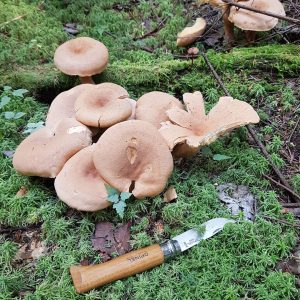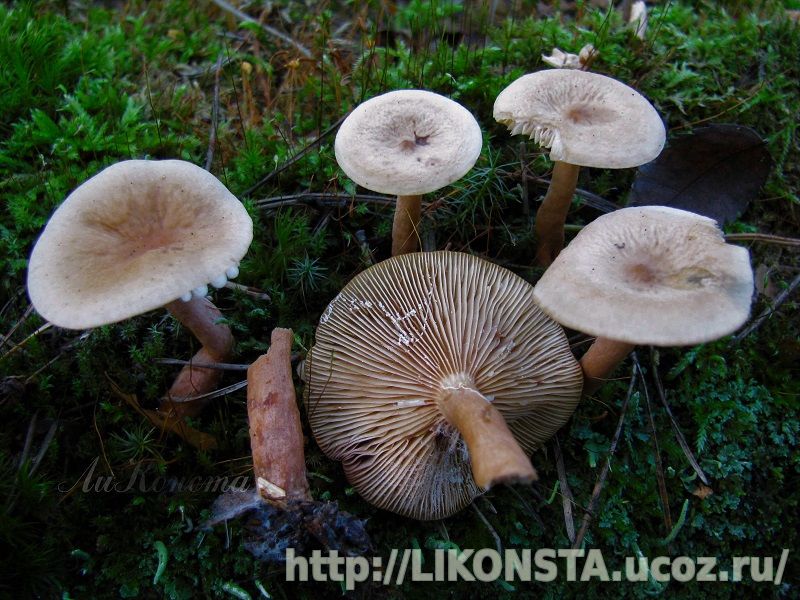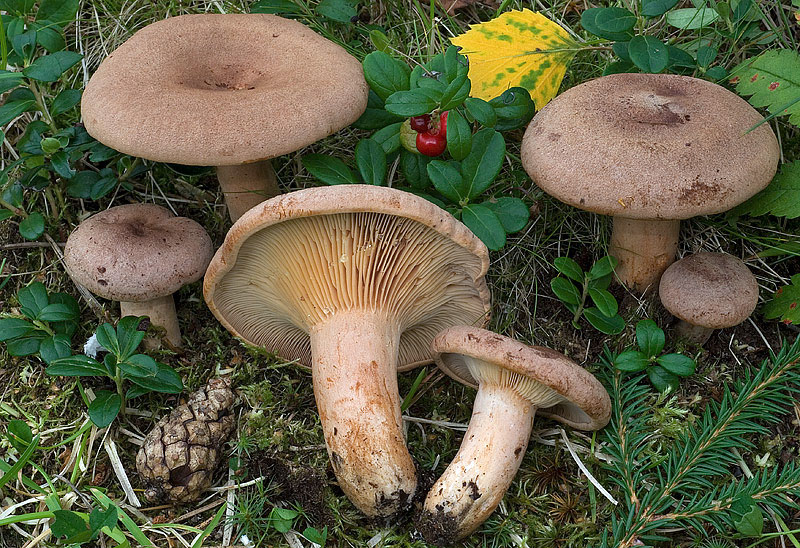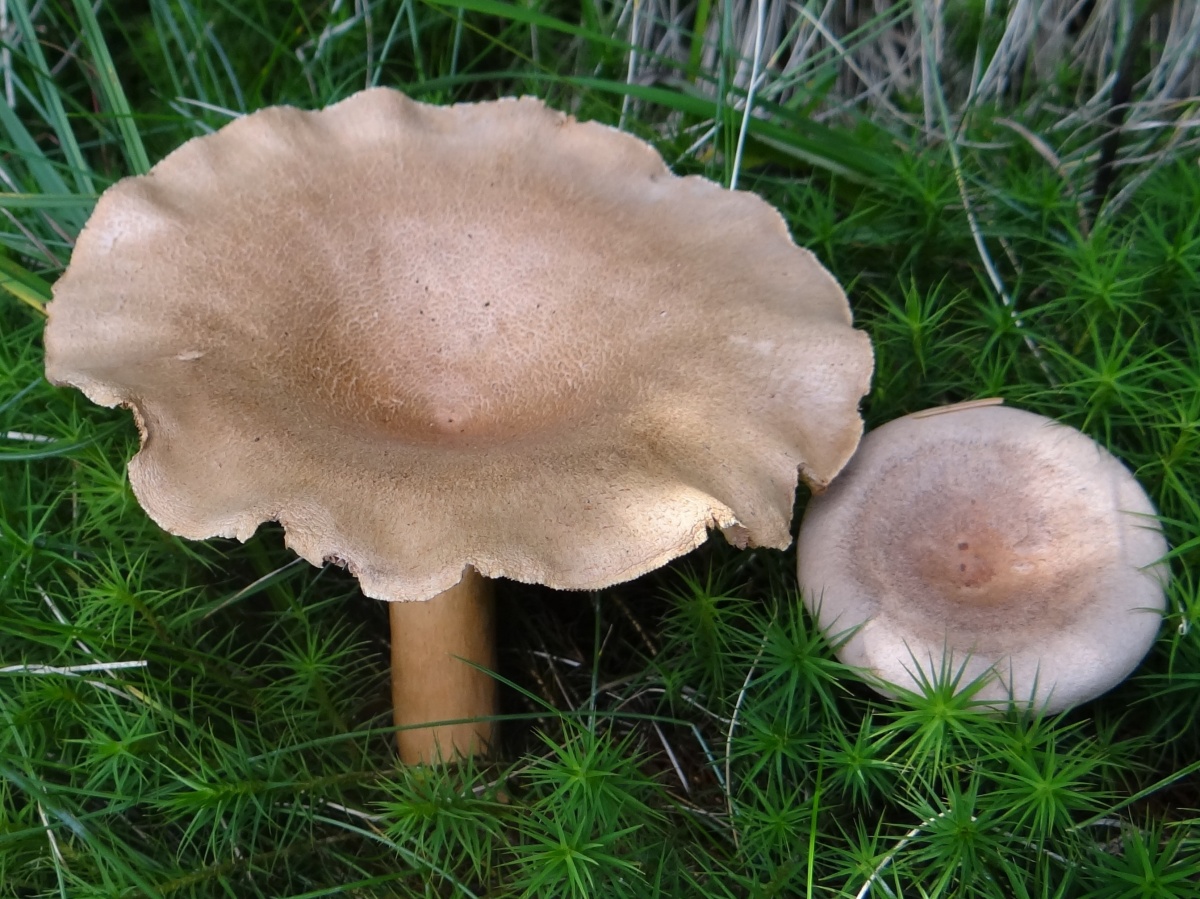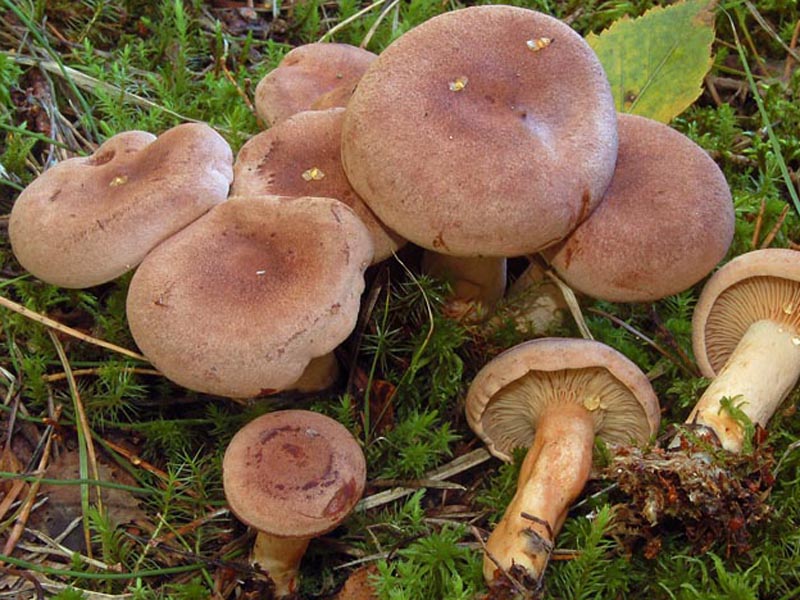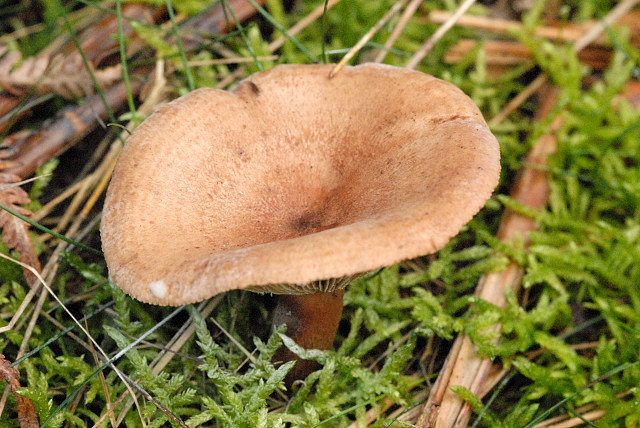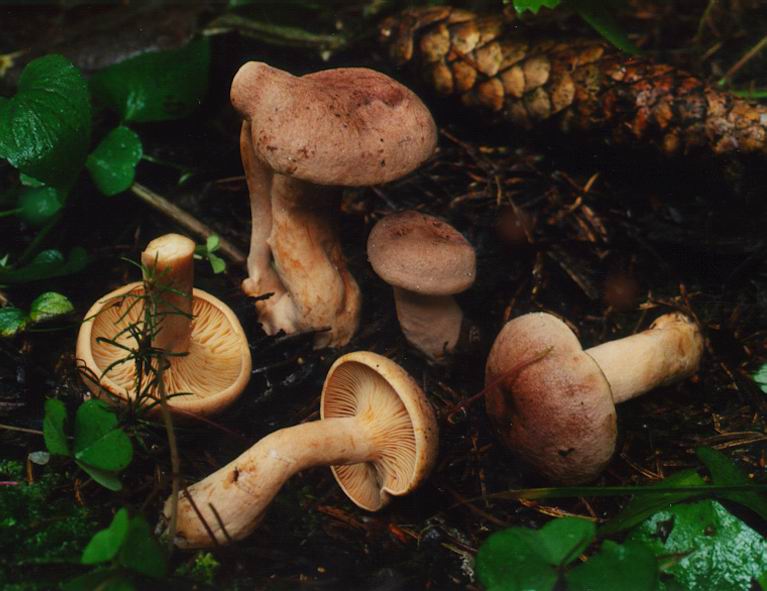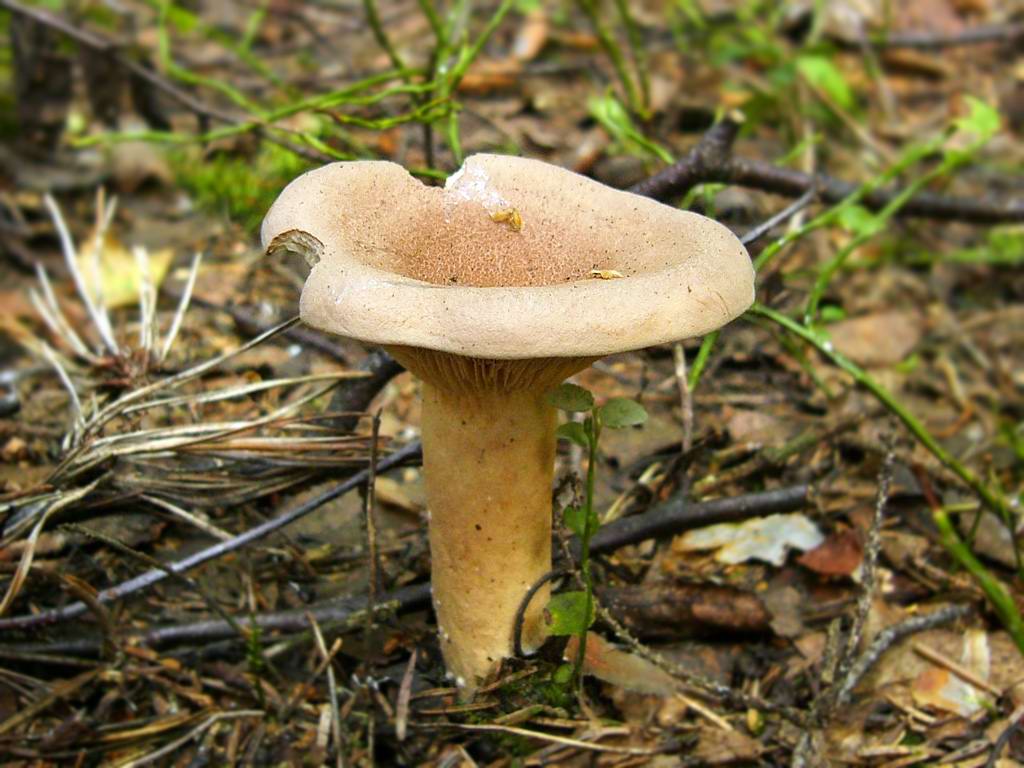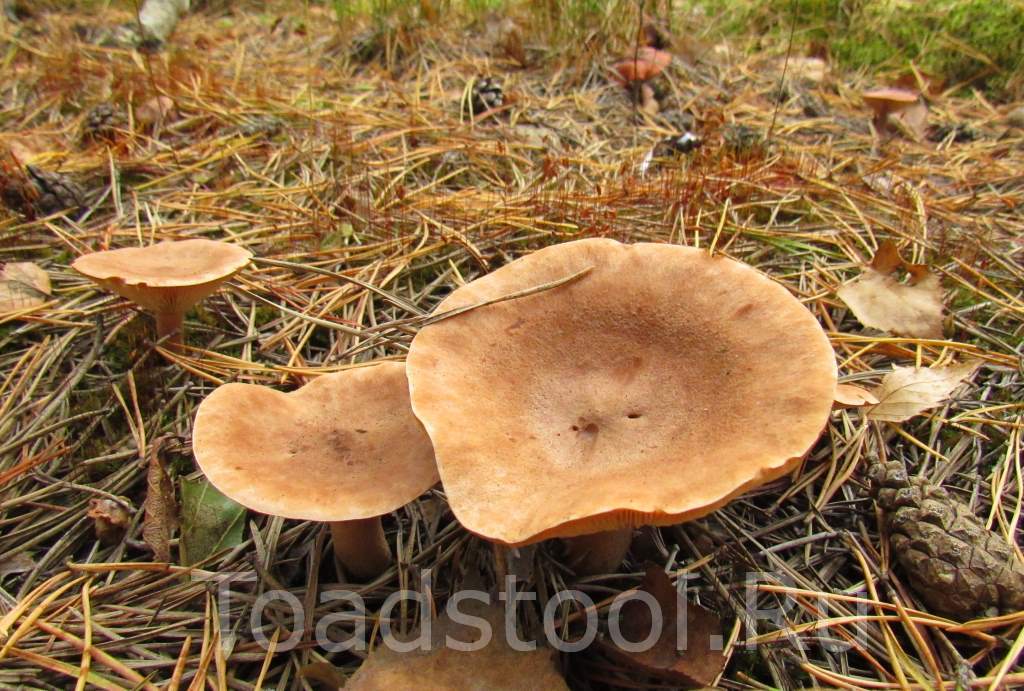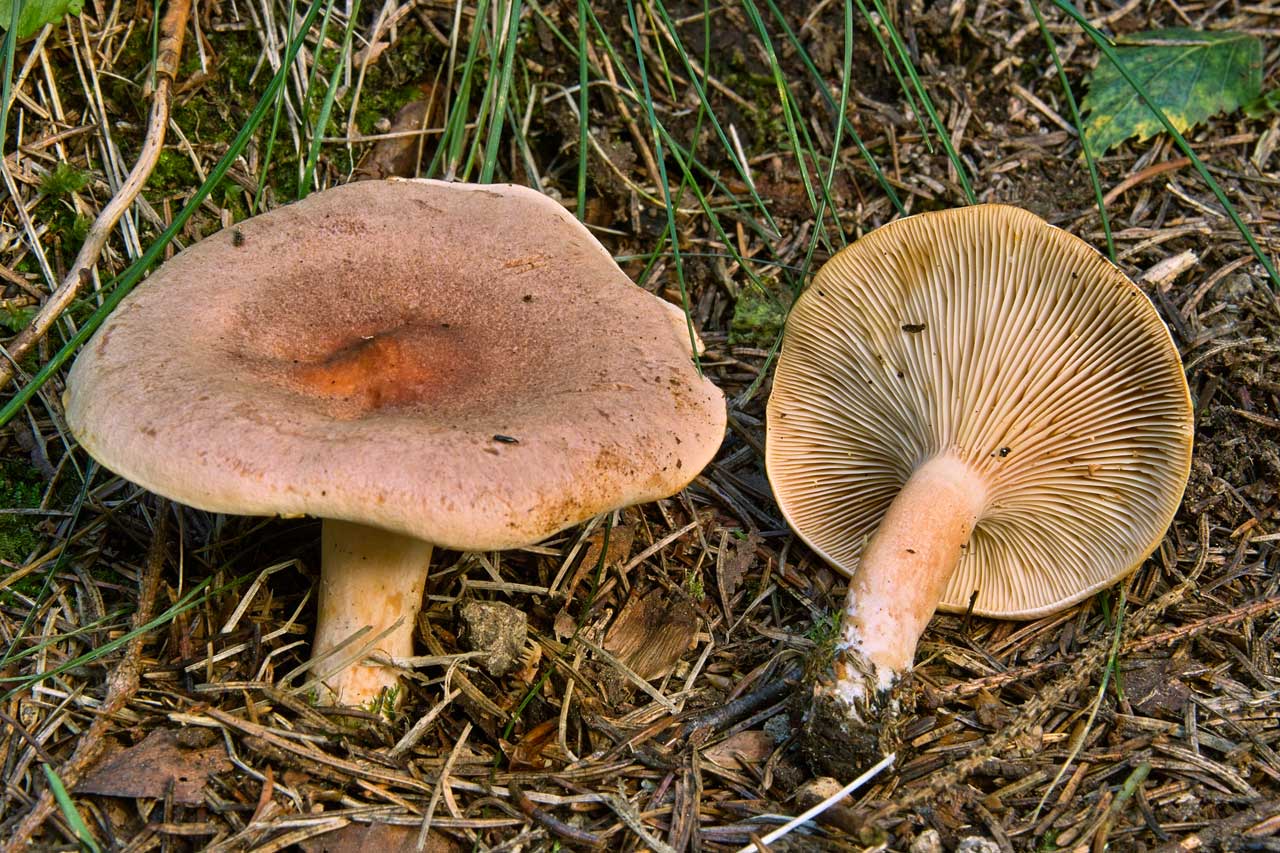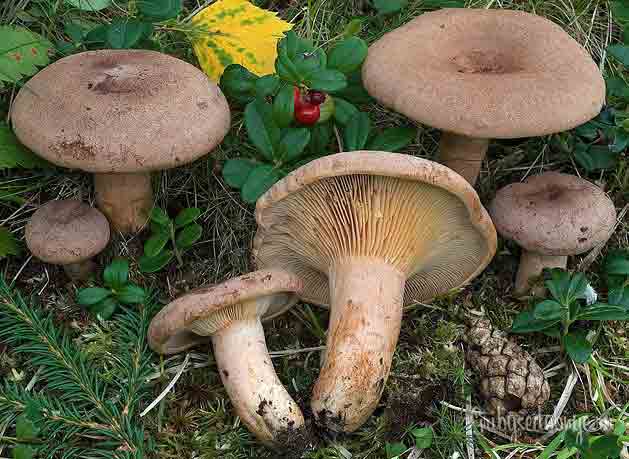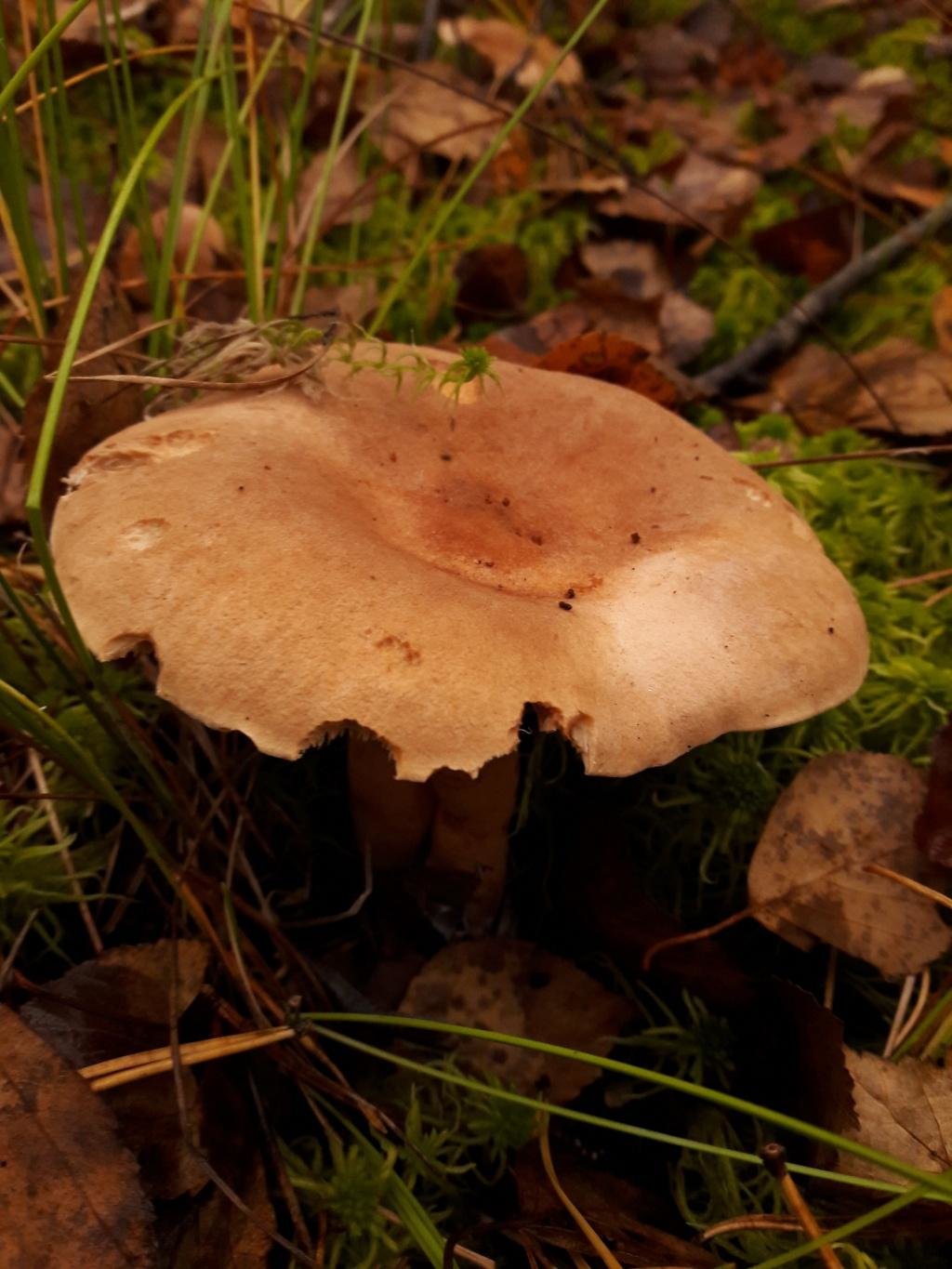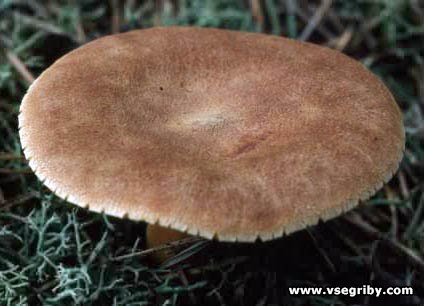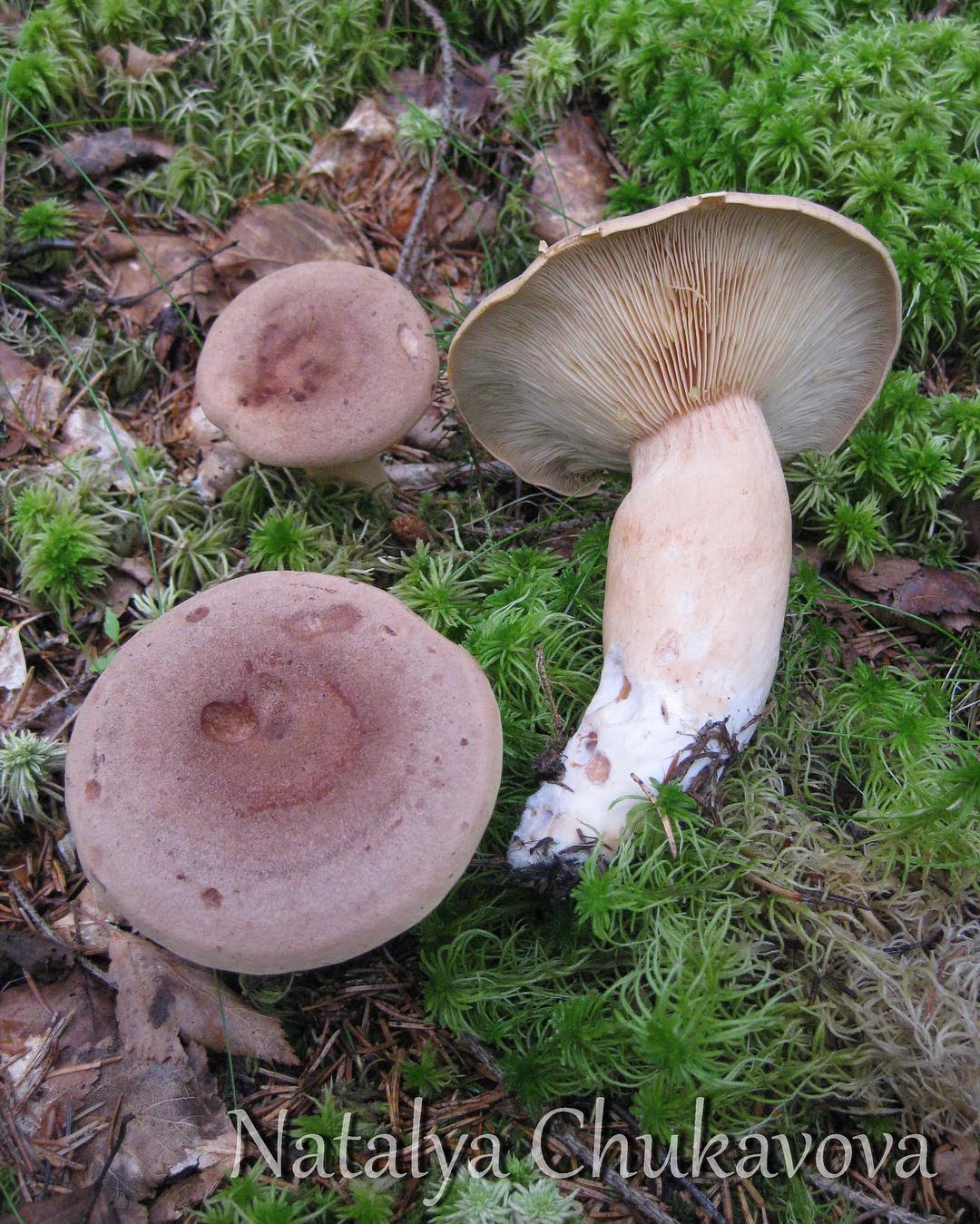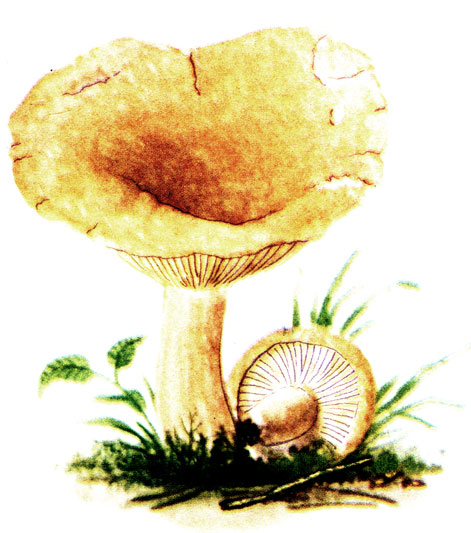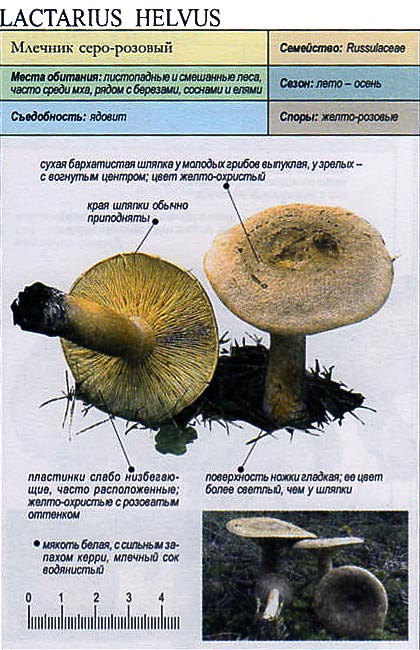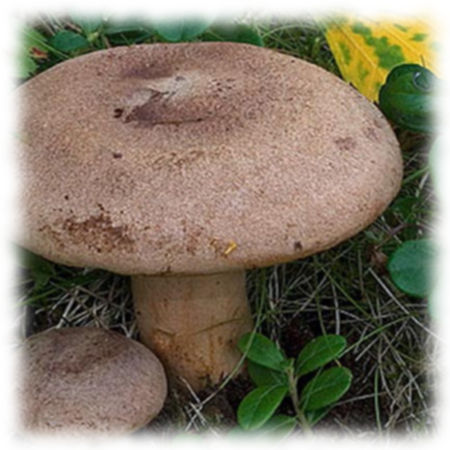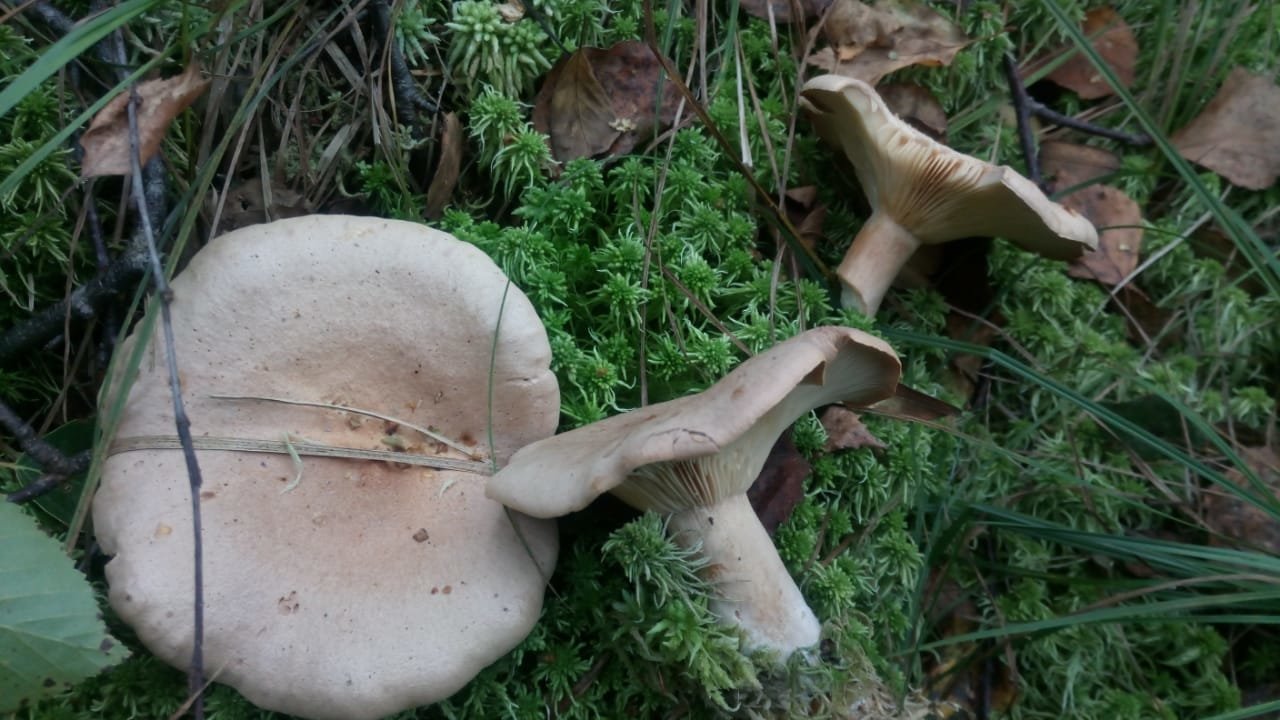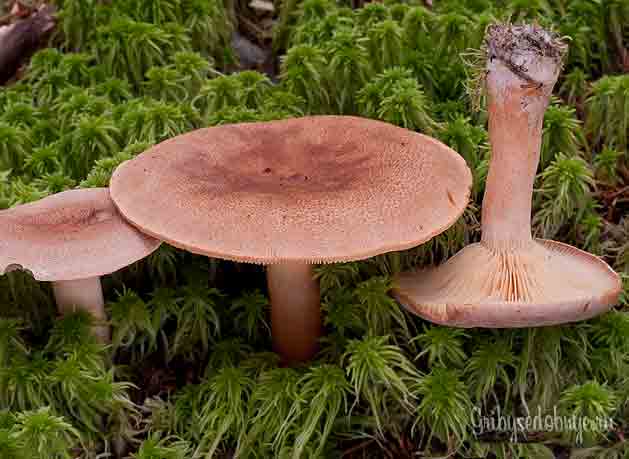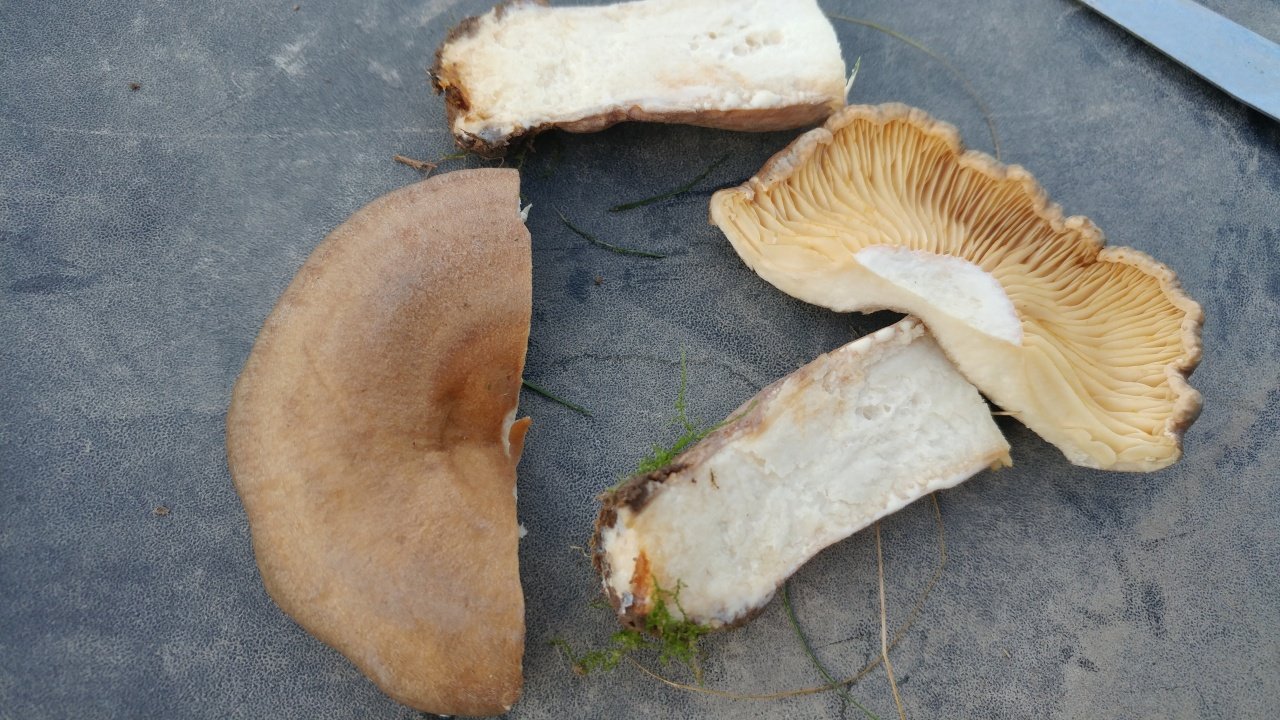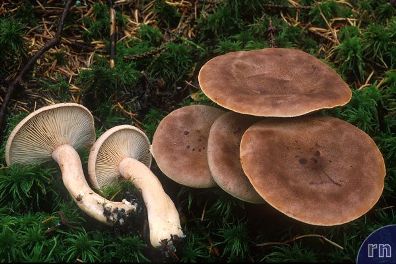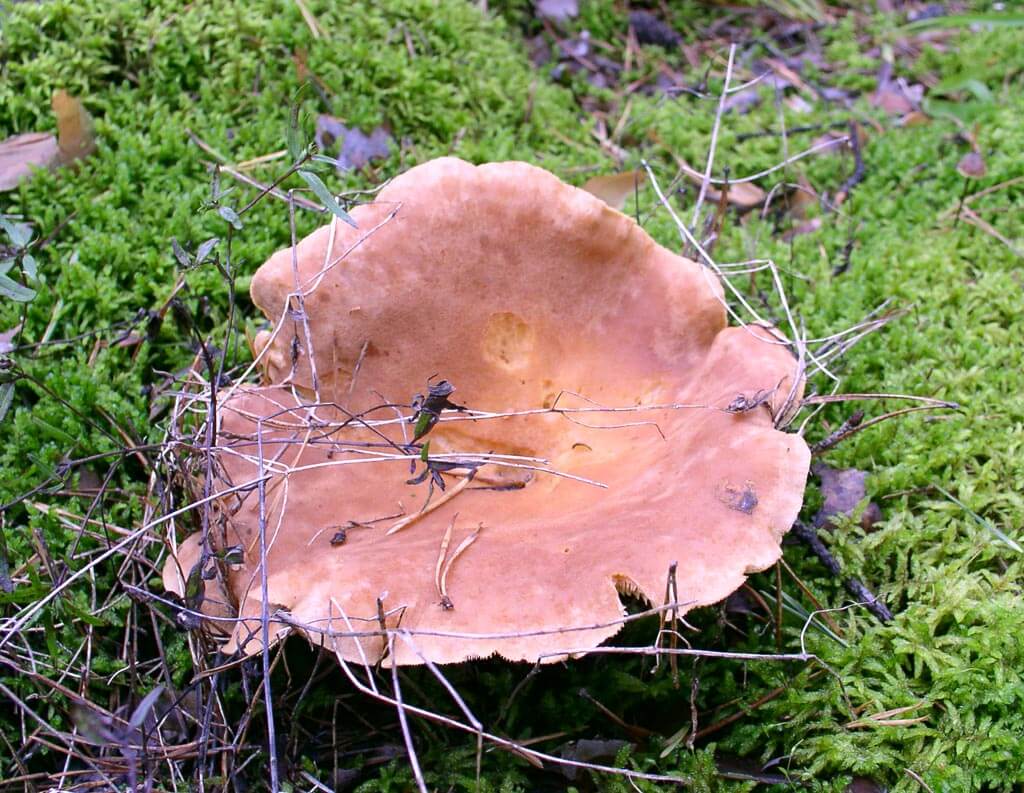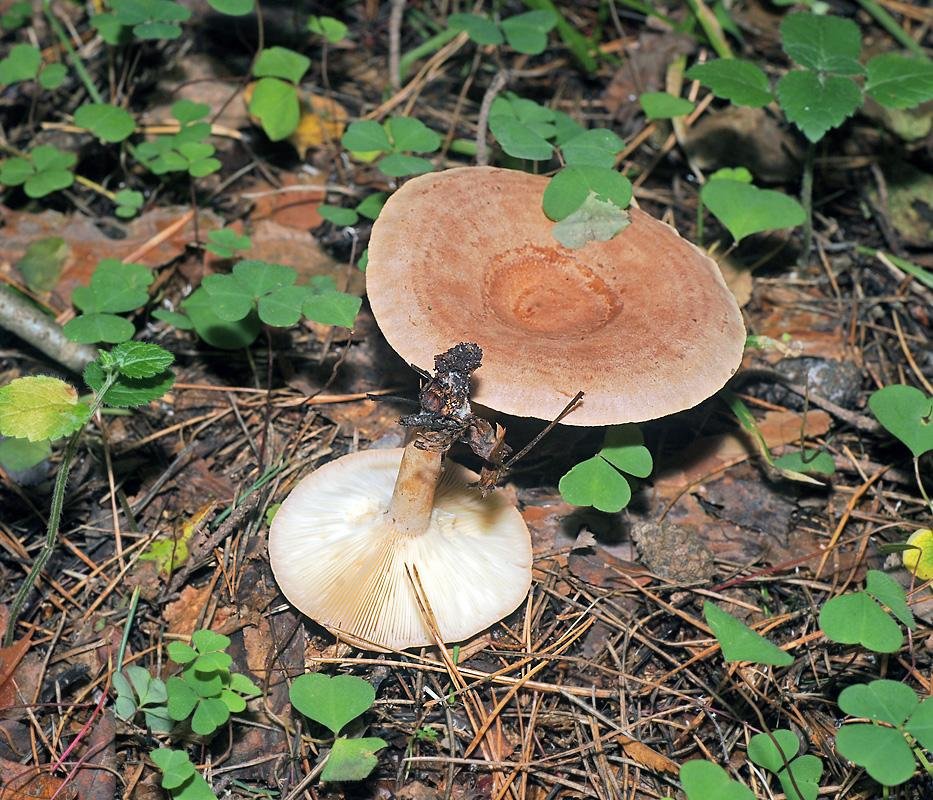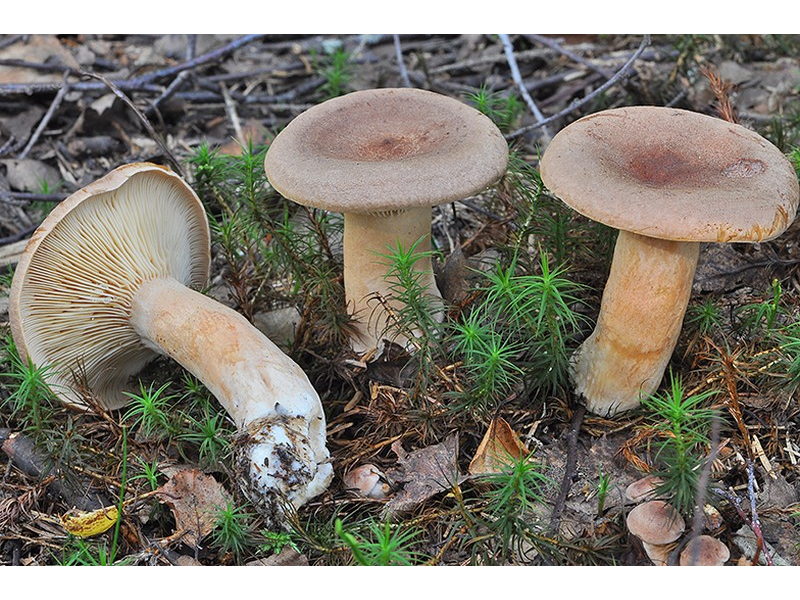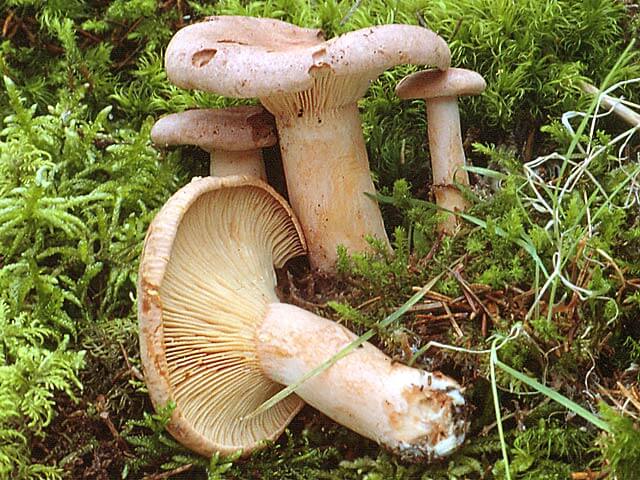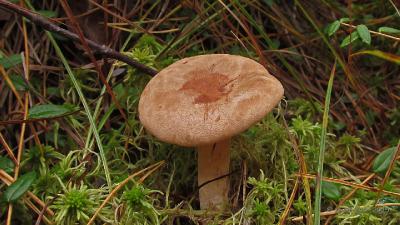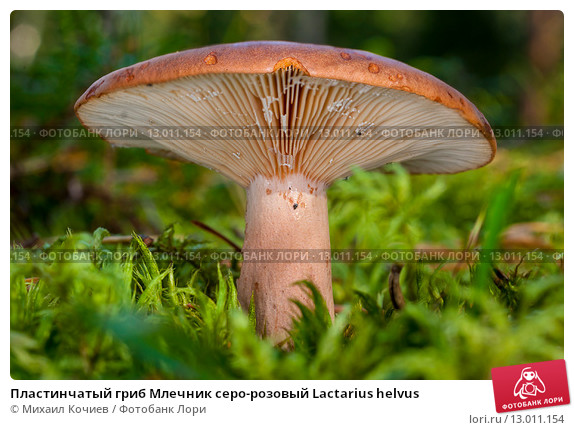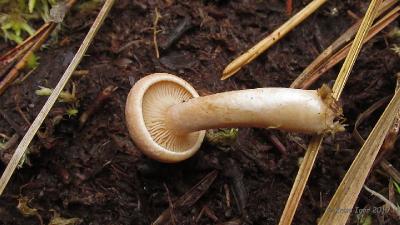Description of the mushroom
Representative of the Mlechnik family, the Syroezhkov family. The species was given the Latin name Lactarius helvus in 1838 by the Swedish botanist and mycologist Elias Magnus Fries.
Gray-pink milky is often called gray-pink or inedible milk mushroom, as well as common, roan or amber milky. The mushroom is considered inedible, but it is not classified as poisonous.
The cap in young specimens is flat, later becomes funnel-shaped, reaches 12 cm in diameter. The edge looks curled down, in the center there is a tubercle. Skin color is brown with a pink tint, sometimes grayish. In dry weather, a silky sheen appears.
The hymenophore (the lower part of the cap) has the form of plates, rather weakly adhered to the stem and descending along it. The color is often whitish, and changes to fawn or pink with age. Spores are creamy ocher, rounded, reticulate.
The pulp is often light yellow, pale yellow, exudes a strong unpleasant odor, very spicy, similar to chicory, tastes with bitterness. On the cut, the color does not change. The milky juice is scanty, watery, whitish in color, slightly pungent in taste. Miller does not change color on contact with air.
The stem has the shape of a cylinder, reaches 9 cm in height, up to 2 cm in diameter. Young mushrooms have a loose stem, the same shade as the cap, in old ones it becomes hollow. Closer to the hymenophore, the color is somewhat lighter, mealy, whitish fibers can be seen below.
Time and place of fruiting
Fruiting time is from July to September, most often found in the temperate zone closer to the north. Mycorrhiza forms with spruce and pine, sometimes with birch. Loves wet places, acidic soils. Most often it can be found in forests among mosses, in blueberries, as well as on the outskirts of sphagnum bogs. Remains dry even in the rainy season, grows in large groups.
Properties
- The fruits in question and similar species contain an impressive amount of valuable amino acids. Among the main ones are glutamine, arginine, leucine and tyrosine. In addition, the pulp of the fruit bodies is saturated with fatty acids. Among these, palmitic, stearic, acetic and oil should be distinguished.
- Almost all representatives of this species of fungi are rich in lipoids, phosphatides and essential oils. An ordinary lactarius contains a huge amount of glycogen and fiber, while there is no starch in it at all. In addition, the mushroom is saturated with an abundance of trace elements. A natural antibiotic, lactarioviolin, was found in one of the species. It helps to effectively fight tuberculosis.
- Also, many types of milkmen have a positive effect on the human body. Valuable chemical compounds can fight gallstone disease, acute and purulent conjunctivitis. The fruit contains an antibacterial substance that effectively suppresses Staphylococcus aureus.
- If you want to pickle mushrooms, then for such purposes it is best to choose an ordinary milkman. Due to processing in this way, fermentation occurs in the composition of the fruit body. Because of this, a pleasant sour aftertaste appears. It is this characteristic that is very much appreciated when salting mushrooms.
The fruits in question are quite fleshy. Not all mushroom pickers are in a hurry to use the mushroom in cooking. This is due to a very unusual smell. Otherwise, after preliminary boiling, such fruiting bodies can be used without problems for preparing other dishes.
Literature
- "Funghi" - Instituto Geografico De Agostini, Novara, Italia, 1997
- Garibova L. V., Sidorova I. I. Mushrooms. Encyclopedia of the Nature of Russia. - M .: 1999.
- F.V. Fedorov, Mushrooms. - M., Rosagropromizdat
- Gorlenko M. V. et al. Mushrooms of the USSR. - M .: 1980
- Bulakh E.M. Lower plants, mushrooms and bryophytes of the Soviet Far East. Mushrooms.. - L.: Nauka, 1990 .-- T. 1. - S. 13-55. - 407 p.- ISBN 5-02-026578-0.
- Gorovoy L.F. Morphogenesis of lamellar fungi. - Kiev: Naukova Dumka, 1990 .-- 166 p. - ISBN 5-12-000791-0.
- Perova N.V., Gorbunova I.A. Macromycetes of the south of Western Siberia. - Novosibirsk: Publishing house of the SB RAS, 2001 .-- 158 p. - ISBN 5-7692-0460-5.
- Shaporova Ya.A. Russular mushrooms of Belarus: Lactarius and Russula (milky and russula). - Minsk: Belarusian Science, 2007 .-- 275 p. - ISBN 978-985-08-0814-1.
- V. I. Shubin Mycorrhizal fungi of the North-West of the European part of the USSR. (Environmental characteristics). - Petrozavodsk: Karelian branch of the USSR Academy of Sciences, 1988 .-- 216 p.
- Basso M. T. Fungi Europaei. - Alassio, Italia: Massimo Candusso, 1999. - Vol. 7 Lactarius Pers. - 844 p. - ISBN 88-87740-00-3.
- Bessette A., Bessette A. R., Harris D. B. Milk Mushrooms of North America. - Syracuse, USA: Syracuse University Press, 2009 .-- 299 p. - ISBN 0-8156-3229-0.
- Funga Nordica / Editors Knudsen H., Vesterholt J .. - Copenhagen, Denmark: Nordsvamp, 2008 .-- 965 p. - ISBN 978-87-983961-3-0.
- Heilmann-Clausen J., Verbeken A., Vesterholt J. Fungi of Northern Europe. - Odense, Denmark: Skive Offset, 1998. - Vol. 2: The genus Lactarius. - 288 p. - ISBN 87-983581-4-6.
- Kränzlin F. Fungi of Switzerland. - Luzern, Switzerland: Verlag Mykologia, 2005. - Vol. 6 Russulaceae. - 318 p. - ISBN 3-85604-260-1.
- Rayner R. W. British fungus flora. Agarics and Boleti. - Oxford, UK: Alden Press LTD, 2005. - Vol. 9 / Russulaceae: Lactarius. - 318 p. - ISBN 1-872291-34-1.
False doubles
| View | Morphology | Habitat | The main danger |
| Amanita regalis | The cap is from 7 to 16 cm, spherical in young mushrooms and almost flat in adults. The color is dark brown, olive-red, sometimes gray-yellow. The stem is slender, no more than 20 cm in length, with noticeable globular thickenings at the bottom. The pulp of the mushroom is yellowish-white, does not have a specific smell. | Prefers moist coniferous forests of the European part of Russia. Representatives have also been found in Korea and Alaska. | It is a poisonous and highly toxic representative of the kingdom due to the content of muscimol, which causes damage to the nerve endings. |
| Fly agaric, chunky fly agaric (Amanita excelsa) | The cap does not exceed a diameter of 12 cm, brown, silvery-brown with light gray remnants of the bedspread. The pulp has a faint turnip smell. | Drought tolerant and ubiquitous | The mushroom is considered conditionally edible, however, due to its similarity with other representatives of fly agarics, which are very poisonous, the collection and use of this type is not recommended. |
| Leopard or gray mushroom (Amanita pantherina) | In appearance, it is almost identical to Amanita rubescens | Found in all types of forests in the Northern Hemisphere | Despite the fact that this mushroom is included in the Red Book of Russia, it is dangerous. It contains muscarine, muscaridin, hyoscyamine. Because of this composition, the panther fly agaric is extremely toxic. Poisoning can be fatal. |
| Amanita phalloides | The cap rarely reaches 15 cm, mostly 10 cm. It has a silky skin, greenish-olive color. The cap, as the fungus ages, acquires a flat-convex, outstretched shape. The stem is thin and does not exceed 20 cm, with greenish veins and expansion in the lower part. | The pale grebe prefers moist forests. It is difficult to find it in arid regions. It is not whimsical to the type of soil and feels best in deciduous forests (it grows extremely rarely in conifers). | Extremely dangerous. The body and the leg contain a huge amount of phalloidin, which is a heavy toxin that affects the parenchymal organs. |
Below are photographs in which you can see that, despite the obvious similarity, the twins still have a number of differences from the pearl fly agaric.
Difference from the poisonous fly agaric panther
Distinguishing these two members of the genus from each other is not so difficult. Despite the almost identical appearance, the panther fly agaric never changes the color of the pulp when damaged (gray-pink always turns red).
Poisonous and inedible species of milky mushroom
Sticky Miller (Lactárius blénnius)
Inedible mushroom.
The diameter of the cap is 4-10 cm, the shape is convex, later extended, the edge is curved. The surface of the cap is shiny, sticky, gray-green in color with dark concentric zones. Leg 4-6 cm long, 2.5 cm in diameter, light. The pulp is white, odorless, the taste is sharp, peppery. Milky juice is thick, white.
Mycorrhiza forms with deciduous trees, grows in summer and autumn in small groups in deciduous forests of Europe and Asia.
Gray-pink Miller (Lactárius hélvus)
Inedible mushroom.
The cap is 6-12 cm in diameter, the shape is flat, later funnel-shaped, the edge is curled up. The color is pinkish brown. The leg is 9 cm high, 1.5-2 cm thick, cylindrical in shape, the color matches the cap. The pulp is light yellow in color. The smell is strong, spicy, unpleasant. The taste is bitter. Milky sap is watery white.
Grows in coniferous forests in the northern temperate zone. The fruiting season is from July to September.
Liver miller (Lactárius hepáticus)
Inedible mushroom.
Hat 3-6 cm in diameter, liver-brown color, smooth surface. The leg is 3-6 cm in height, 0.6-1 cm in thickness, cylindrical in shape, color like a cap. The flesh is thin, creamy or light brown in color, acrid.
Forms mycorrhiza with pine.
Dark Miller (Lactárius obscurátus)
Inedible mushroom.
The cap is 1.5-3 cm in diameter, in a young fungus it is flat, later goblet, the edge is wrinkled, the surface is matte, the color is ocher-brown. The leg is 0.5 cm in diameter, 2-3 cm in height, cylindrical in shape, color like a cap. The pulp is brittle, brown in color. Milky juice is white.
Grows in mixed and deciduous forests, from mid-July to September.
Resinous black miller (Lactárius pícinus)
Inedible mushroom.
The hat is 4-10 cm in diameter, the shape is convex, later spread out. The surface is velvety, brownish brown. The leg is 3-6 cm high, 1-1.5 cm thick, cylindrical in shape, tapering towards the base. The pulp is white, dense, the smell is weak, fruity, the taste is sharp, peppery, turns pink in the air. The milky juice is thick, white, turns red in air.
Grows in small groups or singly in coniferous and mixed forests. The season starts in mid-August and lasts until the end of September.
Orange Miller (Lactárius pornínsis)
Inedible mushroom.
The hat is 3-8 cm in diameter, the shape is convex. Orange color, smooth surface.
The leg is 3-6 cm long, 0.8-1.5 cm in diameter, cylindrical in shape, tapering towards the base, in a young mushroom it is solid, later hollow, the color coincides with the cap. The pulp is dense, fibrous, the smell is orange. Milky juice is thick, sticky, white.
Grows in deciduous forests, in small groups, in summer and autumn.
Wet Miller (Lactárius úvidus)
Inedible mushroom.
The diameter of the cap is 4-8 cm; in a young mushroom, the shape is convex, later prostrate. The edge is bent. The color is grayish-steel with a violet tinge, the surface is smooth and damp. The pulp is odorless, the taste is pungent, white or yellowish, turns purple on the cut. Milky juice is abundant, white, turns purple in air. The leg is 4-7 cm high, 1-2 cm thick, strong, cylindrical.
A rare mushroom that grows in damp deciduous and mixed forests, from early August to late September.
Red-brown Milk (Lactarius volemus)
Synonyms:
- Galorrheus volemus
- Lactifluus volemus
- Amanita lactiflua
- Lactarius lactifluus
- Lactifluus oedematopus
- Lactarius oedematopus
- Lactarius ichoratus
- Galorrheus ichoratus
- Lactifluus ichoratus
- Lactarius testaceus
- Millechnik is the best (by the way, the official Russian-language mycological name)
- Podoreshnik (Belarusian - Padareshnik)
Lactarius volemus (Fr.) Fr., Epicr. syst. mycol. (Upsaliae): 344 (1838)
Description
A hat with a diameter of 5-17 (up to 16) cm, convex in youth, then prostrate, possibly pressed in the center, and even up to concave. The edge of the cap is straight, thin, sharp, first tucked up, then straightened and even raised. The color is reddish-brown, brownish-brown, in rare cases, rusty or light buffy. The surface is velvety at first, then smooth and dry. Often cracked, especially in dry conditions. There is no zonal coloration.
Flesh: White, yellowish, very fleshy and firm. The smell is described in various ways, mainly as a herring (trimethylamine) smell that increases with age, but there are more interesting associations, for example with pear flowers, or not at all. The taste is soft, pleasant, sweetish.
The plates are frequent, from adherent to weakly descending, creamy or warm skin shades, often forked at the leg. There are shortened plates (plates).
Milky sap is abundant, white, turning brown and thickening in the air. For this reason, this type of lactarius turns brown and everything else if damaged - pulp, plates.
The leg is 5-8 (up to 10) cm high, (1) 1.5-3 cm in diameter, hard, often full, the color of the cap, but slightly paler, smooth, may be covered with fine pubescence, which looks like frostiness, but not to the touch felt. Often tapered to the bottom.
The spore powder is white. The spores are close to spherical, according to the data 8.5-9 x 8 µm, 9-11 x 8.5-10.5 µm each. The ornamentation is ridged, up to 0.5 µm in height, forming an almost complete network.
Habitat
Occurs from July to October. One of the earliest milkmen.Grows in deciduous, mixed and spruce forests (in general, in all forests). According to the data, it forms mycorrhiza with oak (Quercus L.), common hazel (Corylus avellana L.) and spruce (Picea A. Dietr.).
Similar species
Given the "power" of this mushroom and the abundant brownish sweetish milky juice, perhaps, it has no similar species. The most similar lactic to him, perhaps, is the hygrophoroid lactarius - Lactarius hygrophoroides, but it is easily distinguished by non-brown milky juice and rare plates. Quite conditionally, rubella (Lactarius subdulcis) can be attributed to similar species, but it is thin-fleshed and slender. The same applies to the orange lactarius (Lactarius aurantiacus = L. mitissimus), it is not only small and thin, but also late, does not overlap in terms, although it grows in exactly the same biotopes with spruce.
Edibility
An edible mushroom that can be eaten raw. It is good in raw salted or pickled form, without any heat treatment. I don't like it in another form because of the "wooden" pulp, although, they say, mushroom caviar is good from it. I hunt him specifically and purposefully, for the sake of raw salting.
Literature Used 1) Verbeken, A. & Vesterholt, J. 2008. Lactarius. - In: Knudsen, H. & Vesterholt, J. (eds.): Funga Nordica, 82-107.2) Flora of Belarus. Mushrooms. In 7 volumes. Volume 1. O.S. Gapienko, Ya.A. Shaporova, 2012, Boletales. Amanitales. Russulales.
Video about the miller mushroom:
Study history
Genus Lactarius was isolated in 1797 by the Dutch botanist-mycologist Christian Heinrich Person, first under the name Lactaria consisting of six types: L. piperata, L. pallida, L. lateritia, L. torminosa, L. opaca and L. xylophila... In 1799 Person published in his book Observationes Mycologicae information about these species, using the variant as the name of the genus Lactarius... In 1801, the number of species in the genus was, according to Persona, 17, and according to his contemporary, British botanist Samuel Frederick Gray - 12. Both researchers indicated the color of the cap as the main criterion for separating species between themselves.
The Swedish mycologist Elias Magnus Fries, in an 1863 publication, indicates the color and taste of milky sap and the color of the plates as signs that make it possible to distinguish intrageneric groups of species, thus highlighting 3 groups: Dapetes, Piperites and Russulares.
In 1889, the German mycologist Joseph Schroeter proposed an idea (though not further developed) about the division of the genus Lactarius for two: Lactaria and Lactariella based on the color of the spore powder and the microscopic characteristics of the spores.
An important stage in the development of ideas about the genus system was the classification proposed in 1888 by the French mycologist Lucien Kele, based on the nature of the surface of the cap. Kele distinguished three sections: Glutinosi, Pruinosi and Velutini, respectively with a sticky, dry smooth and velvety / hairy cap. This system was later developed in the works of other scientists: A. Rikken, P. Konrad and J. E. Lange.
In subsequent works, the number of intrageneric taxa of different levels increased, mainly due to the systematization of new tropical species. Thus, the French mycologist Roger Aime singled out in the genus Lactarius 3 subgenus: Eulactarius, and Venolactarius and Lactariopsis, including predominantly tropical species.
The German mycologist Walter Neuhoff published a classification of the genus in 1956, where microscopic features of the structure of the pileipellis (cap skin) were first used for division into sections. This feature is one of the main ones today.
Modern ideas about the structure of the genus began to form with the appearance in 1979 of the work of American mycologists Lexemuel Ray Hesler and Alexander Henchett Smith "North American species of Lactarius", where both micro- and macroscopic characters were used to isolate intrageneric taxa. Genus Lactariuswas thus divided into 6 subgenera, 18 sections and 5 subsections.
The last major works devoted to the genus Lactarius are monographs by J. Heilmann-Clausen, A. Verbeken, J. Westerholt “Fungi of Northern Europe. vol. 2: The genus Lactarius, M. T. Basso, Lactarius Pers., R. W. Rainer, British Fungus Flora: Agarics and Boleti. vol. 9 Russulaceae: Lactarius "and A. Bessetta, A. R. Besset, D. B. Harris" Milk mushrooms of North America.
Significance in human life [| ]
According to M.V. Vishnevsky, all species of the genus are edible.
In Europe, the overwhelming number of species of the genus Lactarius
considered inedible, or even poisonous. In Russia, many species are considered edible, usually in salted or pickled form.
Some lactosers are used in medicine. From this mushroom (Lactarius deliciosus
) and close to it red mushroom (Lactarius sanguifluus ) with red milky juice, the antibiotic lactarioviolin was isolated, which suppresses the development of many bacteria, including the causative agent of tuberculosis. Pepper milk (Lactarius piperatus ) is used in the treatment of kidney and gallstone diseases, blennorrhea, acute purulent conjunctivitis. Bitter (Lactarius rufus ) contains an antibiotic substance that adversely affects a number of bacteria, as well as inhibits the growth of cultures of Staphylococcus aureus [source not specified 1347 days ].
Pickled shiitake mushrooms, usually grown in China, are often sold under the name "pickled milk mushrooms" and are also edible.
In philately
As of 2020, there have been at least 114 different postage stamps issued around the world with images of the dairymen.
Lactarius piperatus on a Moldavian postage stamp (# 694) Lactarius piperatus on a Romanian postage stamp (# 4290)
- Lactarius blennius - Guinea (# 2523)
- Lactarius camphoratus - Guyana (# 3683), Mauritania (# 1059), Niger (# 1734)
- Lactarius chrysorrheus - Guinea-Bissau (# 3863)
- Lactarius claricolor - Madagascar (# 1632)
- Lactarius deceptivus - Mali (# 1484)
- Lactarius deliciosus - Algeria (# 1013), Angola (# 1421), Bulgaria (# 1267) (# 1275), Botswana (# 318), Guinea (# 762) (# 4255) (# 4681) (# 4741), Guinea -Bissau (# 849), Honduras (# 1845), Spain (# 3143), Cyprus (# 924), Lesotho (# 1317), Liberia (# 4025), Mali (# 1480), Mozambique (# 1058), Nicaragua (# 3003), Poland (# 1096), Romania (# 1724) (# 6263), Sao Tome and Principe (# 1631), Saint Vincent and the Grenadines (# 5204), Somalia (# 503), USSR (# 2987), Sierra Leone (# 1078) (# 3723) (# 5215), Togo (# 2355) (# 2818), Turkey (# 3034), Uganda (# 2930), Croatia (# 255), CAR (# 2876)
- Lactarius deterrimus - Afghanistan (# 1845), Norway (# 991), Finland (# 830)
- Lactarius dryadophilus - Greenland (# 465) (# 468)
- Lactarius fulvissimus - Guinea (# 2548) (# 2556)
- Lactarius gymnocarpus - Cote d'Ivoire (# 1194)
- Lactarius helvus - Guinea-Bissau (# 4302), Liberia (# 5240)
- Lactarius hepaticus - Guinea (# 5217)
- Lactarius hygrophoroides - Bhutan (# 2077), Grenadines (Grenada) (# 1447), DPRK (# 3001)
- Lactarius indigo - Guyana (# 6932), Guinea (# 1613), Liberia (# 4026), Mali (# 1485), El Salvador (# 2258), Sierra Leone (# 2573) (# 2579)
- Lactarius lignyotus - Mali (# 1487), Monaco (# 1864), Switzerland (# 2339)
- Lactarius luculentus - Mali (# 1481)
- Lactarius pandani - Madagascar (# 1314) (# 1541)
- Lactarius peckii - Mali (# 1486), Saint Vincent and the Grenadines (# 5210)
- Lactarius phlebonemus - DRC (# 602) (# 1072)
- Lactarius piperatus - Moldova (# 694), Romania (# 4290)
- Lactarius porninsis - Guinea (# 2529)
- Lactarius pseudomucidus - Mali (# 1482)
- Lactarius putidus - Grenadines (Grenada) (# 774)
- Lactarius resimus - Mongolia (# 1138)
- Lactarius rufus - Nevis (# 1146), Saint Vincent and the Grenadines (# 5211)
- Lactarius romagnesii - Bhutan (# 2078)
- Lactarius salmonicolor - Tanzania (# 3793)
- Lactarius sanguifluus - Andorra (Spanish) (# 167), Guinea (# 2525), Spain (# 3104)
- Lactarius semisanguifluus - CAR (# 4377)
- Lactarius scrobiculatus - Zambia (# 846), Cambodia (# 2064), Mali (# 1483), Mongolia (# 350)
- Lactarius torminosus - Belarus (# 973), Bhutan (# 1152), Guinea-Bissau (# 3861), Comoros (# 1485), Mongolia (# 346), Sao Tome and Principe (# 3005), Finland (# 864)
- Lactarius trivialis - Montserrat (# 1205), The Grenadines (Grenada) (# 2619)
- Lactarius turpis - Antigua and Barbuda (# 3427), Nevis (# 1142), Sao Tome and Principe (# 3006)
- Lactarius uvidus - Grenada (# 3587)
- Lactarius vellereus - Niger (# 1501)
- Lactarius volemus - Guinea Bissau (# 5651), Grenada (# 3595), Dominica (# 1403), DPRK (# 4221), Sao Tome and Principe (# 1638) (# 2009)
Gray-pink Miller (Lactarius helvus)
Amber miller
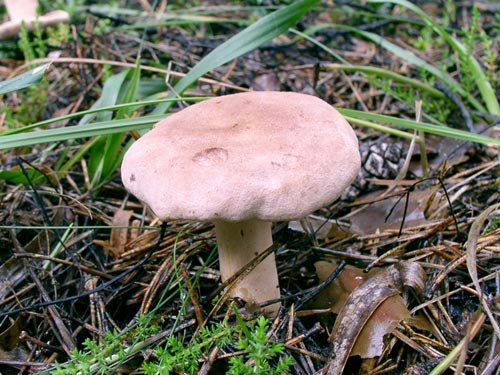
Gray-pink miller (lat.Lactarius helvus) is a mushroom of the genus Miller (lat.Lactarius) of the russula family (lat.Russulaceae). Conditionally edible.
Gray-pink lactarius cap: Large (8-15 cm in diameter), more or less rounded, equally prone to both the formation of a central tubercle and a depression; with age, these two signs can appear at the same time - a funnel with a neat bump in the middle. The edges in youth are neatly tucked up, gradually roll out as they mature. Color - hard to describe, dull grayish brownish pink; the surface is dry, velvety, not prone to hygrophilousness, does not contain any concentric rings. The pulp is thick, brittle, whitish, with a very strong spicy odor and a bitter, not particularly pungent taste. Milky sap is scanty, watery, in adult specimens it may be completely absent.
Plates: Weakly descending, medium frequency, the same scale as the cap, but somewhat lighter.
Spore powder: Yellowish.
The leg of the gray-pink lactarius: Quite thick and short, 5-8 cm in height (in mosses, however, it can be much longer), 1-2 cm in thickness, smooth, gray-pinkish, lighter than the cap, in youth, whole, strong , forms uneven gaps as they grow older.
Distribution: Gray-pink Miller is found in bogs among birches and pines, in mosses, from early August to mid-October; in late August-early September, it can, under favorable circumstances, bear fruit in huge quantities.
Similar species: The smell (spicy, not very pleasant, at least not for everyone - I don't like it) allows you to distinguish the gray-pink milky from other similar mushrooms with complete confidence. For those who are just starting to get acquainted with the milkmen, relying on literature, we will say that another relatively similar mushroom with a strong smelling pulp, the oak milkman Lactarius quietus grows in dry places under oak trees, is much smaller and, on the whole, is not at all similar.
Edible: In foreign literature, it is listed as weakly poisonous; here it is referred to as inedible or as edible, but of little value. People say that if you are willing to put up with the smell, then you get a milkman like a milkman. When it appears in the absence of valuable commercial mushrooms, it is at least interesting.
Remarks An enthusiast of mushroom pleasures is always uncomfortable to admit such things, but Lactarius helvus became one of the few milkmen who made a brightly inedible impression on me. A large, weighty mushroom with an unpleasantly dry cap, not affected by either a worm or a slug, for some reason does not fit into the basket. Perhaps it's a suspicious smell; if it were even a little weaker, it could be called piquant, spicy, or just like a chemical weapon. As with many other common mushrooms growing in pines, I met the gray-pink lactarius very late, at a conscious mushroom age; met and under the first pretext that came across, interrupted the acquaintance. Something is wrong here. Something the same as that of the oak milkman. It seems like a mushroom of a noble family and a valiant article, and not happy. Or the problem is no longer even in the mushroom ...
| Group: | Lamellar |
|---|---|
| Plates: | White, beige-gray-pink |
| Colour: | Beige-gray-pink |
| Info: | Smells like chicory at the break |
| Department: | Basidiomycota (Basidiomycetes) |
|---|---|
| Subdivision: | Agaricomycotina (Agaricomycetes) |
| Class: | Agaricomycetes (Agaricomycetes) |
| Subclass: | Incertae sedis (indefinite) |
| Order: | Russulales |
| Family: | Russulaceae (russula) |
| Genus: | Lactarius (Miller) |
| View: | Lactarius helvus (Gray-pink Miller) |
According to some sources, this type of milkmen is inedible, and according to others, it is conditionally edible. In foreign literature it is noted as weakly poisonous; in the domestic one - as inedible or as edible, but of little value due to a sharp unpleasant odor.
Miller pink-gray
| Group: | Lamellar |
| Plates: | White, beige-gray-pink |
| Colour: | Beige-gray-pink |
| Info: | Smells like chicory at the break |
| Department: | Basidiomycota (Basidiomycetes) |
| Subdivision: | Agaricomycotina (Agaricomycetes) |
| Class: | Agaricomycetes (Agaricomycetes) |
| Subclass: | Incertae sedis (indefinite) |
| Order: | Russulales |
| Family: | Russulaceae (russula) |
| Genus: | Lactarius (Miller) |
| View: | Lactarius helvus (Gray-pink Miller) |
According to some sources, this type of milkmen is inedible, and according to others, it is conditionally edible. In foreign literature it is noted as weakly poisonous; in the domestic one - as inedible or as edible, but of little value due to a sharp unpleasant odor.
Hat
Grows to medium size (up to about 15 cm in diameter). In the middle of it, both an impression and a tuberous outgrowth can form. With the growth of the fungus, both signs appear at the same time. The edges of the cap in young mushrooms are rolled downwards, and open upwards with age. Its color is beige-gray-pink. The surface is not slimy, dry and velvety to the touch.
Pulp
Fleshy, pale and rather fragile. When broken or cut, the pulp smells very strongly of chicory. It tastes bitter. It emits a small amount of milky juice, which resembles water in consistency. The juice does not change color when exposed to air.
Leg
The legs of these milkmen are short and very stocky (approximately 8 * 2). Their color is slightly lighter than the surface of the cap. In young specimens, the legs are full, and in the process of growth they form irregular cavities inside. These milkmen do not have any additional growths on the legs, they are smooth.
Spore-bearing layer
The spore layer is made of plates. Plates of medium thickness and frequency.Almost the same color as the hat, but a little lighter. In very young mushrooms, the plates are almost white, then darken.
Spore powder
The spores of the gray-pink lactarius are almost round, of medium size, with a reticular surface, the bulk of the powder is orange-yellow.
Distribution and collection
The gray-pink milky is distributed throughout the northern hemisphere in a temperate climate. Usually it forms mycorrhiza with conifers such as pine or spruce, but in other conditions it can grow next to deciduous, in particular, birch. This species prefers acidified soils, which are usually found in thickets of blueberries and near swamps.
Similar species
This type of milkman has practically no twins due to its extremely specific smell.
But outwardly, it may look like:
It features an implicit concentric pattern on the head. In addition, the smell is different - the oak milkman smells like hay, not chicory. In general, this mushroom is smaller and grows mainly near oak trees.
This mushroom is also distinguished by a more modest size and a darker color, predominantly brownish-red. Doesn't smell like chicory like the gray-pink variety.
Useful properties, medical applications and restrictions on use
Milk mushrooms have long been used in folk medicine for the treatment of purulent wounds, kidney diseases and other diseases. Most of the species have anti-tumor and antibacterial effects. The fruit contains vitamins that have a beneficial effect on the nervous system and prevent the development of sclerosis.
Lactose
Medicines made on the basis of milk mushrooms help cope with kidney stones. The blue milk mushroom contains a natural antibiotic that has a detrimental effect on staphylococci. In some fruits, scientists have discovered lactarioviolin, an antibiotic that helps to destroy the pathogens of tuberculosis.
Most of the mushrooms of this genus are conditionally edible fruits, so they need to be heat treated before eating. You cannot harvest near highways, factories and plants, it is better to do this in ecologically clean areas. It is not advised to eat these fruits for gastrointestinal diseases, pregnancy and breastfeeding.
Recipes and cooking features
Mushrooms of this kind can be fried, boiled and pickled, but in this form their taste is muted. Salty and fermented milkers are characterized by good taste. Ryzhiks do not require prolonged soaking, but bitters, milk mushrooms and waves should be soaked for a while in cold water.
Here are some delicious recipes:
- If the basket is filled with mushrooms, this is a great reason to please loved ones with fried mushrooms. The crop is washed and cleaned from forest debris. Each copy is cut into 5-7 pieces and laid out in a preheated pan with sunflower oil.
Fried mushrooms The fire should be medium so that the water from the mushroom mass evaporates faster. When the water has boiled off, reduce the heat and fry for about 15 minutes. At this time, you can add finely chopped onion, salt and fry for about another five minutes.
- To prepare delicious Korean mushrooms, you will need the following ingredients:
- milkmen (any bitter mushrooms);
sugar;
soy sauce;
table vinegar;
fresh garlic;
hot pepper;
ground coriander.
Millers in Korean
The fruits are pre-boiled 2-3 times for 30 minutes, each time changing the water. It is desirable that a slightly bitter taste remains in them, which will give the dish a special piquancy. Boiled fruits are seasoned with soy sauce, sugar and a little vinegar are added. The resulting mass is thoroughly mixed with the addition of the necessary spices. The finished dish should be allowed to brew for several hours in the refrigerator.

